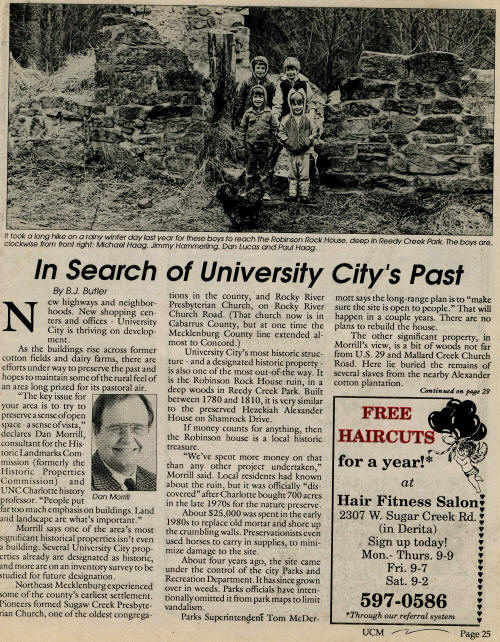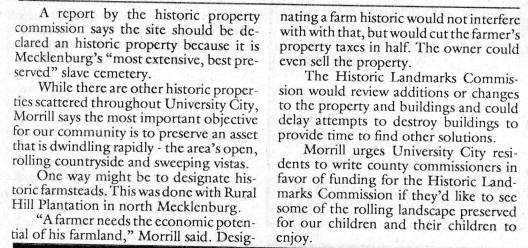
This report was written in January 1984.
1. Name and location of the property: The property known as the W. G. Rogers House is located at 524 East Boulevard, in Charlotte, North Carolina.
2. Name, address, and telephone number of tile present owner of the property:
The present owner of the property is:
Mr. John B. Geer
800 Bromley Road
Charlotte, NC 28207
Telephone: (704) 372-4499
3. Representative photographs of the property: This report contains representative photographs of the property.
4. A map depicting the location of the property:This report contains a map which depicts the location of the property.
5. Current Deed Book Reference to the property: The most recent deed to this property is listed in Mecklenburg County Deed Book 4607 at page 544. The Tax Parcel Number of the property is: 121-051-12.
6. A brief historical sketch of the property: This report contains a brief historical sketch of the property prepared by Dr. William B. Huffman.
7. A brief architectural description of the property: This report contains an architectural description of the property prepared by Mr. Thomas W. Hanchett.
8. Documentation of why and in what ways the property meets the criteria set forth in N.C.G.S. 160A-399.4:
a. Special significance in terms of its history, architecture, and/or cultural importance: The Commission judges that the property known as the W. G. Rogers House does possess special significance in terms of Charlotte-Mecklenburg. The Commission bases its judgment on the following considerations: 1) the initial owner and most probably the designer of the house was Willard G. Rogers, an architect of local and regional importance and from 1906 until about 1916 a partner of C. C. Hook; 2) the W. G. Rogers House, erected in 1902, is one of the earliest examples of the Dutch Colonial Revival style in the city of Charlotte; and 3) the W. C. Rogers House is a well-preserved example of upper middle class housing in turn-of-the-century Dilworth, Charlotte’s first streetcar suburb.
b. Integrity of design, acting, workmanship, materials, feeling and/or association: The Commission contends that the attached architectural description by Mr. Thomas W. Hanchett demonstrates that the W. C. Rogers House meets this criterion.
9 Ad Valorem Tax Appraisal: The Commission is aware that designation would allow the owner to apply for an automatic deferral of 50% of the Ad Valorem taxes on all or any portion of the property which becomes “historic property.” The current appraised value of the .241 acres of land is $31,500. The current appraised value of the improvements is $38,980. The total current appraised value is $70,480. The property is zoned 06.
The modest but attractive house built by longtime Charlotte architect Willard G. Rogers and his wife, Eva, at 524 East Boulevard in Dilworth, reflects the middle-class comfort typical of much of Charlotte’s first streetcar suburb. Dilworth was developed by Edward Dilworth Latta beginning in 1891, and was facilitated by the installation of the city’s first electric streetcar line (which replaced an older, horse-drawn one) in that year by his company, the Charlotte Consolidated Construction Company, commonly known as the 4C’s. Originally laid out in a grid pattern repeating those of the center city, and for which East and South Boulevards were the main streets, Dilworth’s main attraction, from 1891 to 1909, was Latta Park at the end of the trolley line. The beautifully landscaped park, complete with a lake and pavilion, hosted many sporting events and traveling shows, and was the outdoor social center of the city. Dilworth was always an eclectic neighborhood, which ranged from the mill village surrounding the Atherton Cotton Mill (1892-3, built by D. A. Tompkins, the city’s New South industrialist) on the south side of the town, to the various modest but solid houses of a prospering middle class, to the great houses of the wealthy. Latta himself built his grand manse on East Boulevard in 1902 on the site presently occupied by the Greek Orthodox Church.1
It was the same year that Willard and Eva Troy Rogers bought their property from the 4C’s on the same side of the street less than a block away.2 Willard G. Rogers (1863-1947) and Eva Troy Rogers (1871-1942) were both natives of Cincinnati, Ohio. They moved to Charlotte about 1900, where he was employed as an architect for Stewart W. Cramer, who later operated the Cramerton Mills in Cramerton. At the turn of the century, Cramer had his own engineering and contracting firm which built and supplied cotton mill machinery and equipment. In 1940, the East Boulevard house was sold to Mae King Blume, who bought a number of Dilworth properties in the Thirties and Forties, including the Walter Brem house at 211 East Boulevard, where she lived for many years. Mrs. Blume, the widow of John H. Blume, was, in the Thirties, the proprietor of the Piedmont Hotel, Queen City Hotel, Frances Hotel, Windsor Hotel, Southern Hotel, the Franklin Hotel and the manager of the New Albert Hotel.3 In 1982, the house was sold to the present owners, Gary Benner and John Geer, who, the year before, had also bought and restored the old W. T. McCoy house designed by Hook and Rogers.4 The Rogers house well deserves preservation and restoration as part of Dilworth’s heritage as a valued and distinct part of turn-of-the-century Charlotte.
The W.G. Rogers house is one of Charlotte’s earliest examples of the Dutch Colonial Revival architectural style. Built about 1902, the one and a half story dwelling features the barn-like gambrel roofs characteristic of the style. Rogers was among Charlotte’s first architects, and he incorporated many “state-of-the-art” architectural features in his residence which are worthy of note. The massing of the W.G. Rogers house is simple and straightforward, in keeping with the dislike for Victorian complexity which many young architects felt around the turn-of-the-century. It is basically a square box with no wings. The gambrel roof has a large gambrel-roofed front dormer, and a large shed-roofed rear dormer which extends all the way across the back of the house. The roof is slate with copper guttering. A pair of exterior end chimneys contribute to the symmetrical effect. Walls are sheathed in wood shingles. The double-hung sash windows each have a large single-pane lower sash, and an elaborately geometrical upper sash composed of four main vertical panes and as many as twenty-four smaller triangular panes. The front dormer features a dentilled cornice and a bay window flanked by Doric columns. In early years this bay was an open balcony, but soon after the house was built Rogers glassed it in. Below the dormer is the recessed front porch, which originally ran the entire width of the front of the house. It has Doric columns set on a substantial brick railing wall, which is an extension of the brick main foundation of the house. A pair of round-arched openings at ground level containing fan lights provide natural illumination for the basement, and add an additional compositional element to the street facade. In the 1940s part of this porch was enclosed, and the front roof was extended slightly. The center entry has an elaborate transom of beveled glass over a pair of heavy wooden doors.
Inside, one moves through a small vestibule before entering the stairhall, which extends across the left front of the house. Next to the door, beneath the stair, is a Victorian inglenook. The stair rises in three flights. Its slender turned balusters are in the Colonial Revival style, but its unusual newel posts proclaim Rogers’ independence from strict interpretation of the style. The bullet-like wooden form of the main post is embellished with raised floral carving and a snake-like extension of the balustrade rail. The upper newel post has a cylindrical fluted shaft and a capstan top. The remainder of the interior lay-out shows the same eccentric mix of ideas found in the stair-hall. There is no center hallway, a feature used by many Colonial Revival architects, including Roger’s eventual partner C.C. Hook. Instead, rooms open one to another, somewhat in the Victorian manner. In the ceiling of the second floor hallway is a trapdoor to the attic. It contains a ladder that slides down on a system of pulleys, a noteworthy early example of the type of mass-produced ladder now common in suburban houses. The attic is unfinished. The yard of the W.G. Rogers house is rather compact, with narrow front and side yards. At the rear is a small gable-roofed servants’ house. It originally had three rooms, all sheathed inside with horizontal tongue-and-groove boarding. A small addition was added at its rear at a later date. Next to the servants’ house is the public alley which runs through the middle of this block. The W.G. Rogers house was converted to apartments in the 1940s, and has suffered some changes over the years. Part of the front porch was enclosed, and cut-glass transoms over the large front windows were removed and stored in the attic. The panelled pocket doors off the front stair hall were cut in order to insert conventional door jambs. A downstairs bathroom and two upstairs efficiency kitchens were added. Woodwork was painted and repainted, and plaster walls were allowed to crack and deteriorate. In the 1980s owner John Geer is restoring the residence. He has replaced modern windows, inserted in the front bay in recent years, with handcrafted replicas of the originals. He is beginning to strip woodwork and repair plaster, and has painted the wood-shingled exterior. Despite its years of deferred maintenance as rental property, the Rogers residence is surprisingly close to the way that its architect left it. Its room arrangement, expensive woodwork, and exuberant bathrooms are almost entirely as they were designed, as is its Dutch Colonial Revival exterior. The W.G. Rogers house is important to Charlotte as a rare early example of the architect’s art.






